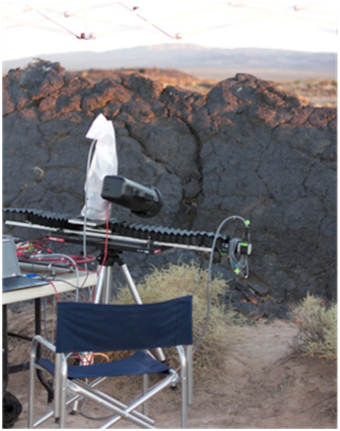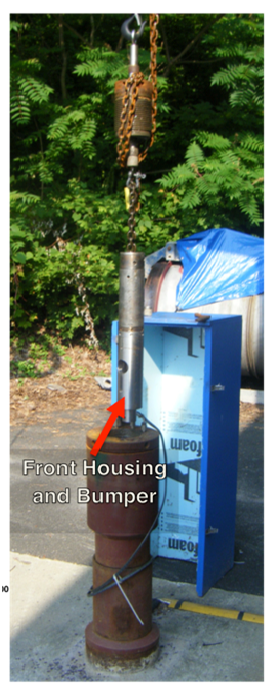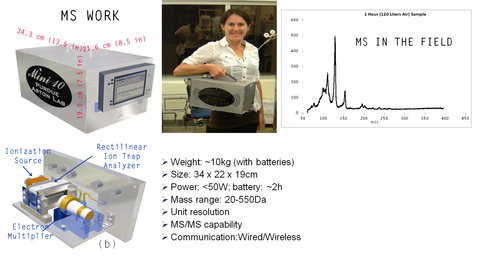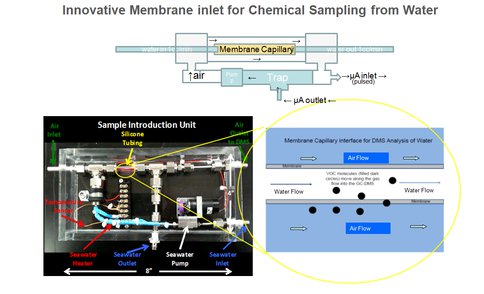2011 Annual Science Report
 NASA Jet Propulsion Laboratory - Icy Worlds
Reporting | SEP 2010 – AUG 2011
NASA Jet Propulsion Laboratory - Icy Worlds
Reporting | SEP 2010 – AUG 2011
Path to Flight
Project Summary
Our technology investigation, Path to Flight for astrobiology, utilizes instrumentation built with non-NAI funding to carry out three science investigations namely habitability, survivability and detectability of life. The search for life requires instruments and techniques that can detect biosignatures from orbit and in-situ under harsh conditions. Advancing this capacity is the focus of our Technology Investigation.
Project Progress
The (Field Instrumentation and) Path to Flight investigation’s purpose is to enable in-situ measurements of organics and biological material with field instrumentation that have high potential for future flight instrumentation. The preceding three Investigations provide a variety of measurable goals used to modify or “tune” instrumentation that can be placed in the field. In addition the members of this Investigation provide new measurement capabilities that have been developed with the specific goal of life-detection. The instrument arsenal goes beyond the commercially available instrumentation and brings next generation imaging spectrometers, chromatographic, and sample extraction devices.
The Path to Flight investigation has three (3) primary Objectives, all of which have been progressing well in year 1. Below are the objectives and a list of accomplished tasks.
OBJECTIVE1: Chemistry at Hydrothermal Vents
- Measurements associated to Laboratory Hydrothermal Vent and other Inv. 1 developments.
OBJECTIVE2: Survivability and Presence in Ice
- Detection of organics using Cryofluorescence Spectroscopy
OBJECTIVE3: Ground Truth and Observability
- Modification of Instrumentation for deployment in Barrow, Alaska
- Collaborative Development of Subsurface In-situ Microbial Detector (DEBI-T)
- Collaborative Development and Field Applications of Portable Mini 10 Mass Spectrometer (MS) system
- Development and Field Applications of Field Portable Differential Mobility Spectrometer (DMS) system to obtain knowledge about the survival of organics in extreme conditions.
The following are some additional details associated to the accomplished tasks and preparations for near-term and long-term tasks.
Chemistry at Hydrothermal Vents
To better understand the mineralogy of the laboratory hydrothermal chimney’s beging developed in investigation 4, we used instrumentation being developed for future in-situ missions including Raman spectroscopy and XRD. For these samples, Raman spectroscopy provides a unique capability to observe the micro-mineralogy rather than the bulk material. As such we have identified FeS species including mackinawite (including nanocrystalline features) and gregite (Mielke et al 2011). Further characterization to understand the distribution of mineral species is underway in FY12.
Survivability and Presence in Ice
Co-I’s P. Johnson, R. Hodyss, and R. Bhartia have demonstrated use of deep UV native fluorescence spectroscopy at cryogenic temperatures that not only provide electronic information of the molecule but vibrational features begin to appear at temperatures similar to those on icy bodies (Johnson et al 2011). These vibrational features are much like those observed by Raman spectroscopy however the efficiency of the response is 1e6 times greater. While the spectrometer requirements are less complex than necessary for Raman spectroscopy, narrow line deep UV sources, such as those used in the experiments (NeCu 248.6 nm hollow cathode laser – Photon Systems Inc), are necessary to observe the narrow spectral lines. These results suggest that rover/lander based missions searching for organics on icy bodies may be able to capitalize on instruments, such as the recently funded ASTID – GURILA (PI: R Bhartia), without the added complexity of Raman spectroscopy.
Ground Truth and Observability
This area represents the largest collective effort in Investigation 4; however, because of the significant expense involved with field instrumentation development, efforts for leveraged activities are essential. A major field effort for the Icy Worlds domain is the focus on the Alaska campaigns. For this endeavor, a deep UV native fluorescence instrument (TUCBE – Targeted UV Chemical Biological Explorer – Photon Systems/JPL) whose development has been in part funded by DoD as well as NASA Planetary Protection Research, will be deployed in the coming fiscal year. Under the NAI hardening of the scanning pan/tilt stage has been completed. For a local test prior to deployment in Alaska, we successfully deployed the instrument in the Mojave. In addition to operation from batteries, the instrument demonstrated capability to operate in a bright, high UV, outdoor environment, as well as detect organics on natural surfaces. These results were confirmed from air measurements that were conducted by a portable miniature mass spectrometer that was also tested in the field (Figure 4-1).

Figure 4-1. Deep UV Native fluorescence mapping instrument in a preliminary field test in Mojave, CA.
In addition to the Alaska field endeavor, Co-I R. Bhartia and post-doc E. Salas, in collaboration with the lead center C-DEBI (Katrina Edwards – USC), Photon Systems – (W. Hug/R. Reid), and Lamont-Doherty Columbia University (G. Itturino), a new deep ocean, deep UV native fluorescence instrument for subsurface in-situ detection of organics and microbes living on borehole walls (DEBI-T) was designed, developed, tested and was successfully deployed in an IODP mission (PI: K. Edwards) to legacy and newly drilled boreholes in North Pond located near the Mid-Atlantic Ridge in (Oct 2010 – Nov 2011) (Figure 4-2). The development of the instrument was spurred by results of label-free microbial detection that was demonstrated in part, in year 1 and 2 of the Icy Worlds NAI (R Bhartia et al 2010). In addition to supporting the Astrobiological goals of understanding the extent of life, the successful deployment of the instrument demonstrates a side-observing high pressure optical design that could be used to observe ice-boreholes in Greenland and Antarctica, analogs to future Europa missions, with the capability to withstand a tested pressures of greater than 10,000 psi.

Figure 4-2. DEBI-T front-end pressure housing with side-wall observation begin tested in a high pressure chamber.
As a part of Investigation 4, we start by examining life processes we understand on the earth. Signs of life can exist in the form of small organic molecules such as amino acids. Mass spectrometry (MS) is widely accepted as the gold standard for detection technologies which we utilized to gain chemical information on a wide variety of chemical compounds. In this investigation, we demonstrated a portable MS system, the Mini 10.5 (Figure 4-3), for astrobiological applications including in situ hydrocarbon analysis and sediments analysis using an automated sample processing system (ASPS). The ASPS is a sampling device developed at JPL that uses a cation exchange resin to extract amino acids from sediments. Since the amino acid solution eluted from the ASPS is at pH 12 positive ion formation required for MS analysis is inhibited. The pH was reduced without forming excessive salt by adding a small amount of acetic acid to form an ammonium acetate buffer suitable for electrospray ionization. The second part of the study tested a sorbent trap system developed to detect trace atmospheric hydrocarbons in the the Mojave desert. Air sampling was done by drawning air over sorbent tubes that were attached to a sample pump at a rate of 2 liters/min. Carbotrap C sorbent was used to look for aromatic hydrocarbons. During these tests the miniature MS system was able to detect the two most abundant components of diesel exhaust, naphthalene and acenaphthene, as well as other aromatic species likely to be a result of exhaust.
Figure 4-3. A picture of Mini10 field portable MS is shown. Also shown is the primary features of the Mini 10 along with a preliminary spectrum taken at the Mojave desert near the I-40 freeway.. Air was analyzed and volatile organic compounds commonly found in diesel.
For soil analysis, sample was introduced after solvent based extraction at elevated temperature and desalting through an automated sample processing system. Samples were obtained from field sites within the southwestern desert region in California. We compared the mass spectra of extracted solvent without processing, spiked solvents, and completely desalted samples to show the utility of a complex instrument for organic analysis.
As a part of Investigation 4, Investigator Kanik and his group look into the question: What is the organic inventory from Martian ice, soil, rocks and liquid water ?
The question of whether life arose on Mars has been widely discussed in the planetary community, partially because the conditions in its early history may have resembled those of the early Earth. However, the current harsh conditions on Mars, including energetic ultraviolet (UV) radiation, extreme dryness and the presumed oxidizing nature of the soil, are destructive to any organic material that is or was exposed to the Martian surface. Although no organic material could be identified with the Viking Mars landers three decades ago, several space missions will visit the Martian surface in the coming decade to search for organic compounds as well as extinct and extant life. In this context, it is vital to obtain knowledge about the survival of organics in extreme conditions. Measuring the abundance and distribution of organic matter in Mars analogue samples collected in dry deserts is critical to our understanding of preservation.
Recently, NASA’s Mars Reconnaissance Orbiter has found possible evidence for water on the surface of Mars that flows seasonally. The water likely would be salty, in keeping with the salty Martian environment. This also brings out an important question: How can we detect volatile organics in water in the simplest way?
We looked into that question and came up with an innovative design of membrane inlet for Chemical Sampling from salty water (Figure 4-4). We carried out preliminary experiments using BTEX successfully which will be reported in an upcoming publication.
Figure 4-4. Our innovative membrane inlet system for chemical sampling from saline water is shown. Membrane capillary PDMS tubing is about 3 cm length. Capillary has been tested to > 5 atm. (50 m depth ~ 5 atm). Sampling from saline water shows no significant difference from sampling from pure water.
As a part of Investigation 4, Path to Flight, we designed a low-cost flyby concept for a sample return mission to Enceladus, a body with high astrobiological potential. There is ample evidence that liquid water exists under ice coverage, in the form of active geyser regions in the “tiger stripes” area of the southern Enceladus hemisphere. This active plume consists of gas and solid ice particles and enables the sampling of fresh materials from the interior that may originate from a liquid water source. The particles consist mostly of water ice are 1-10 mm in diameter. The chemical composition of the gas component of the plume shows H2O, CO2, CH4, NH3, Ar and evidence that more complex organic species might be present. Since life on Earth exists whenever liquid water, organics and energy co-exists, understanding the chemical components of the emanating ice particles could indicate if life is potentially present on Enceladus. Therefore, it is of utmost importance to return samples from Enceladus’ plume to Earth for comprehensive analyses by multidisciplinary scientists and sophisticated ground laboratories to investigate the nature of chemical and biological signatures of life, both current and past. The icy worlds of the outer planets as Enceladus are testing grounds for some of the theories for the origin of life on Earth.
The LIFE mission concept is envisioned to orbit Saturn (both to achieve lower sampling speeds approaching 2 km/s which would enable more gentle sample collection than Stardust and to make possible multiple flybys of Enceladus), to sample Enceladus’ plume, the E ring of Saturn and the Titan upper atmosphere. With new findings from these samples, NASA could greatly improve the cost effectiveness of the future “life search” missions in outer planets and satellites. Since the duration of the Enceladus plume is unpredictable, it is imperative to capture these samples at the earliest flight opportunity. LIFE could take advantage of a Jupiter gravity assist if it is launched before 2019 to reduce mission life times and also launch vehicle costs. A mission opportunity such as LIFE is extremely rare: it would offer science returns comparable to that of Flagship mission but at a much lower flyby sample return cost as a Discovery Mission.
Publications
-
Bhartia, R., Salas, E. C., Hug, W. F., Reid, R. D., Lane, A. L., Edwards, K. J., & Nealson, K. H. (2010). Label-Free Bacterial Imaging with Deep-UV-Laser-Induced Native Fluorescence. Applied and Environmental Microbiology, 76(21), 7231–7237. doi:10.1128/aem.00943-10
-
Johnson, P. V., Hodyss, R., Bolser, D. K., Bhartia, R., Lane, A. L., & Kanik, I. (2011). Ultraviolet-Stimulated Fluorescence and Phosphorescence of Aromatic Hydrocarbons in Water Ice. Astrobiology, 11(2), 151–156. doi:10.1089/ast.2010.0568
-
Mielke, R. E., Robinson, K. J., White, L. M., McGlynn, S. E., McEachern, K., Bhartia, R., … Russell, M. J. (2011). Iron-Sulfide-Bearing Chimneys as Potential Catalytic Energy Traps at Life’s Emergence. Astrobiology, 11(10), 933–950. doi:10.1089/ast.2011.0667
-
Orzechowska, G. E., Kidd, R. D., Foing, B. H., Kanik, I., Stoker, C., & Ehrenfreund, P. (2011). Analysis of Mars analogue soil samples using solid-phase microextraction, organic solvent extraction and gas chromatography/mass spectrometry. International Journal of Astrobiology, 10(03), 209–219. doi:10.1017/s1473550410000443
-
Sokol, E., Noll, R. J., Cooks, R. G., Beegle, L. W., Kim, H. I., & Kanik, I. (2011). Miniature mass spectrometer equipped with electrospray and desorption electrospray ionization for direct analysis of organics from solids and solutions. International Journal of Mass Spectrometry, 306(2-3), 187–195. doi:10.1016/j.ijms.2010.10.019
-
Tsou, P., Brownlee, D. E., McKay, C. P., Anbar, A. D., Yano, H., Altwegg, K., … Kanik, I. (2012). LIFE: Life Investigation For Enceladus A Sample Return Mission Concept in Search for Evidence of Life. Astrobiology, 12(8), 730–742. doi:10.1089/ast.2011.0813
- Beegle, L.W., Kim, H.I., Kanik, I. & Ryu, E.K. (2011). NASA Tech Briefs “Improved Ambient Pressure Pyroelectric Ion Source”.
- Duong, T.A. & Kanik, I. (2011). DIFFERENTIAL MOBILITY SPECTROMETER WITH SPATIAL ION DETECTOR AND METHODS RELATED THERETO [Patent]. DIFFERENTIAL MOBILITY SPECTROMETER WITH SPATIAL ION DETECTOR AND METHODS RELATED THERETO.
- Eiceman, G.A., Coy, S., Mielke, R. & Kanik, I. (2011, In Preparation). Detection of Organic Compounds with a Field Portable Membrane Introduction Differential Mobility Spectrometer System.
- Soparawalla, S., Duncan, J.S., Ouyang, Z., Beegle, L.W., Fisher, A.M., Kanik, I. & Cooks, G.R. (2012). In Situ Analysis of Organics with a Portable Mass Spectrometer. Engineering in Extreme Environment, Earth and Space 2012 Conference. Pasadena CA.
- Soparawalla, S., Duncan, J.S., Ouyang, Z., Beegle, L.W., Fisher, A.M., Kanik, I. & Cooks, G.R. In Situ Analysis of Organics with a Portable Mass Spectrometer. To be presented at ASCE, Engineering in Extreme Environment.
- Tsou, P., Brownlee, D.E., McKay, C.P., Yano, H., Strange, N., Beegle, L.W., Dissley, R. & Kanik, I. (2011). LIFE: Life Investigation For Enceladus, A Sample Return Mission Concept in Search for Evidence of Life. AGU Fall meeting. San Francisco, CA.
-
PROJECT INVESTIGATORS:
-
PROJECT MEMBERS:
Max Coleman
Co-Investigator
Kevin Hand
Co-Investigator
Michael Russell
Co-Investigator
Steven Vance
Co-Investigator
Robert Cooks
Collaborator
Marc Fries
Collaborator
Everett Salas
Postdoc
Randall Mielke
Research Staff
Ewa Sokol
Doctoral Student
Kirtland Robinson
Graduate Student
Lauren Spencer-White
Graduate Student
-
RELATED OBJECTIVES:
Objective 1.1
Formation and evolution of habitable planets.
Objective 1.2
Indirect and direct astronomical observations of extrasolar habitable planets.
Objective 2.1
Mars exploration.
Objective 2.2
Outer Solar System exploration
Objective 3.1
Sources of prebiotic materials and catalysts
Objective 3.2
Origins and evolution of functional biomolecules
Objective 7.1
Biosignatures to be sought in Solar System materials
Objective 7.2
Biosignatures to be sought in nearby planetary systems




